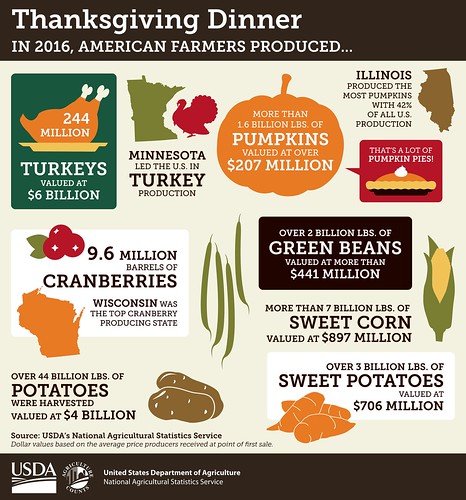
Farmers and ranchers excel at growing what ends up on our tables.
We would like to give thanks this holiday season to America’s farmers and ranchers who help bring delicious food to tables across the nation this holiday season. And just where in the United States are traditional holiday foods produced?
Minnesota is the turkey production champ of the nation, producing 42.5 million birds out of the 244.5 million produced across the nation (PDF, 187 KB) in 2017.
Nearby Wisconsin produced over half of the nation's 9 million barrels of cranberries in 2017.
You can thank Illinois, Texas, and California for the pumpkins; and Georgia, New Mexico, and Texas for the pecans in your pies. North Carolina, California, and Mississippi are major sweet potato producing states, contributing over 3 billion pounds last year.
Farm data provided by U.S. farmers and ranchers and published by the National Agricultural Statistics Service, go hand-in-hand with agricultural policymaking and research. Some of this research leads to interesting developments on your dinner table:
In the 1930s, researchers at USDA’s Beltsville Agricultural Research Center in Maryland set out to breed a variety of turkey that would fit conveniently in the smaller refrigerators of that time. The "Beltsville Small White" turkey breed, eventually introduced to market in 1941, was also bred to have more breast meat and lighter skin, which was more appealing to consumers.
Eventually, consumers preferred a larger turkey, so the poultry industry came to favor the Large White and Broad Breasted White breeds. Descendants of the Beltsville Small White breed can still be found in heritage flocks on small farms, however. You can thank the United States Department of Agriculture for researching options for the poultry industry.
Just a few days after Thanksgiving, NASS will begin mailing the 2017 Census of Agriculture to all farmers and ranchers across the U.S. The census is the opportunity for farmers and ranchers to have a voice in the future of American agriculture, from the creation and funding of assistance programs and services to research and the development of new ag technologies, rural development, and more. We thank formers for their bountiful production and ask them to respond to the census. By responding, farmers and ranchers represent not only their operations but also their communities and industries. Better data mean better decisions. For more information about the census, visit www.agcensus.usda.gov.
